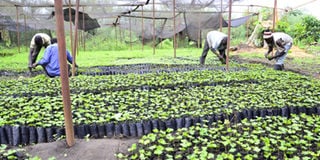How two acres of coffee can earn you Shs32m a year

Coffee seedlings in a nursery where they are prepared before transplanting to the garden. FILE PHOTO
Coffee is Uganda’s leading foreign exchange earner generating more than $422.4m (Shs1.6trillion) every year, and in 2012, the country produced three million 60-kg bags, most of it by smallholder farmers.
And while a lot has been written about coffee and how it is Uganda’s leading traditional cash crop, no one has brought out the real economics of this second most traded commodity in the world, just after oil.
In this article, here is what it takes to grow coffee on a commercial basis.
PLANTING
Planting coffee is not an overnight wonder; it takes adequate preparations. The coffee seedlings should be planted at the onset of the rainy season into holes, two feet by two feet large and at least 45-60cm deep. They (holes) should be dug three months prior to planting.
Spacing
Ideally, Deus Nuwagaba, production officer at National Union of Coffee Agribusinesses and Farm Enterprises (NUCAFE), a body that brings together coffee farmers across the country, says the holes should be filled with topsoil mixed with one bucket/basin of well-prepared manure or compost before planting.
He adds that in addition to a small shade around each young plant that protects it from drought stress, ring mulching keeps the soil around the trees moist.
According to coffee planting guidelines, the spacing defer according the variety, that is, for Arabica, spacing can be 2.5 metres x 2.5 metres while for Robusta, 3 metres x 3 metres is ideal.
Seedlings
Notably, Uganda is the birth place of Robusta and its growing is highly encouraged.
This means an acre of Robusta will accommodate about 1,000 coffee trees. Uganda Coffee Development Authority (UCDA) recommends farmers to buy seedlings from certified nursery operators.
A seedling normally sells from Shs300-Shs500.
As coffee grows, the costs tend to come down but what is crucial in initial stages is to keep the plantation weed free through mulching and other mechanisms like weeding. Coffee starts full production after three years.
Shade trees and intercropping
Given the apparent effects of weather changes, it is recommended to plant shade trees in coffee farms at appropriate spacing and intercrop it with bananas.
Some of the shade trees recommended are nitrogen fixing and enhance the fertility of the soil in addition to protecting it from soil erosion. Shade trees and bananas help protect coffee from drought.
Common tree species that can be used as shade trees in both Arabica and Robusta coffee systems include Grevelia robusta, Ficus natalensis, Albizia coriaria, Mesiopsis eminii, Cordial africana, Acacia or Erythrina spp. Fruit trees such as mango, avocado or jackfruit can also be included at intervals.
Returns
Considering 1000 coffee trees of Robusta in an acre, a farmer can harvest about 8,000 kgs in a year (there are two coffee seasons in a year), taking the average of four kilos per tree under average management.
And taking Shs2,000 as the average price of Kiboko (unshelled coffee cherries), a farmer is able to earn a gross profit of Shs16m. Thus two acres which a serious commercial farmer can manage can make you Shs32m. This is for a farmer who cannot afford to add value to his coffee.
Nuwagaba urges farmers to at least make it a point for their coffee to go through primary processing/hulling or removing of husks from dried cherries. This shelled clean coffee is referred to as FAQ (Fair Average Quality) and fetches higher prices compared to Kiboko.
“In Uganda, a tree can give you 3kgs of FAQ under average management but under good management it can give you even 5kgs. On average, a kilo of parchment (FAQ) is Shs4000,” Nuwagaba says, adding: “In Vietnam, a tree can give you 10kgs of FAQ. The more you add value to your coffee, the higher the returns.”
Maintanance and soil fertility
Nuwagaba says farmers can only remain profitable by testing their soils and feeding it appropriately. “As coffee grows, nutrients are being eaten up in the soil.
A good farmer should put back coffee husks into the farm as long as they are from his farm. If you take your coffee for processing and leave husks there, you are doing what we call soil mining. You are not giving back to the soil,” he cautions.
“If you use virgin land, it will take about four years without using fertilisers. You start mining the soil when you start harvesting,” he addss.
It is not economical to apply fertilisers without soil analysis which many farmers do not carry out. For soil testing, there are simple technologies to keep costs down. For example, there’s a soil testing kit at Makerere University College of Agricultural and Environmental Sciences, which is user friendly though not yet commercialised.
“Nucafe is working closely with the Soil Science Department at Makerere University to roll it out to farmers. It is affordable and user friendly. It can go for Shs250,000,” Nuwagaba says, adding that other ways to detecting missing nutrients in the soil is by looking the health of the plant.
Farmers should always do soil analysis through soil testing for better application of fertilizers.
“We (Nucafe) are promoting farmer ownership model, where the farmer owns the coffee and its products. Whatever comes out of coffee is owned by a farmer,” he says.




